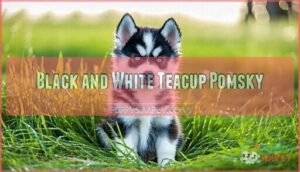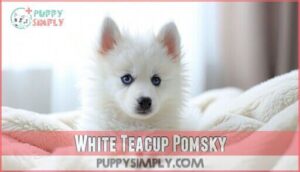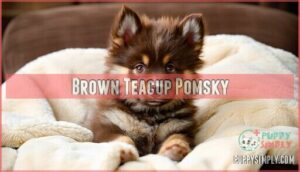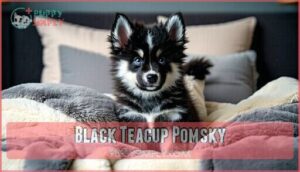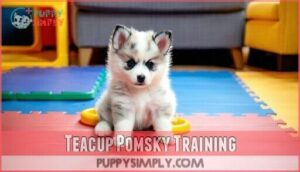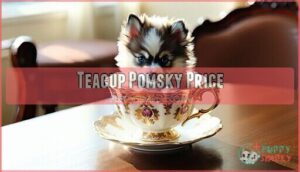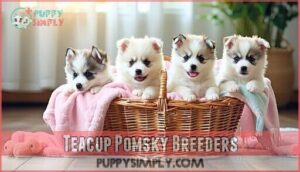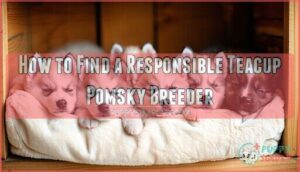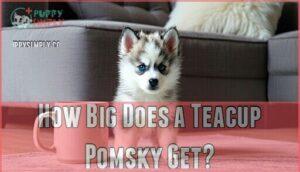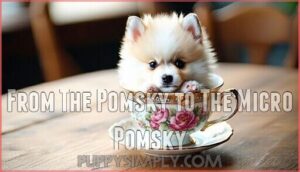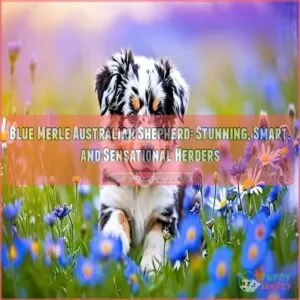This site is supported by our readers. We may earn a commission, at no cost to you, if you purchase through links.
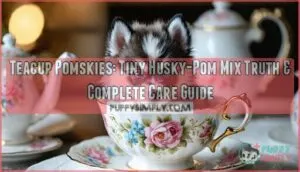
You’ll fall head over heels for their fluffy coats and piercing blue eyes that look like tiny wolves in disguise.
These pocket-sized pups pack big personalities into small packages, but they’re not just adorable accessories.
They need proper care, training, and socialization despite their compact size.
Finding a responsible breeder is essential since some use questionable breeding practices to achieve such small sizes.
Their price tags can make your wallet weep, often ranging from $2,000-$5,000.
Understanding their unique health considerations and care requirements makes the difference between a happy pup and heartbreak.
Table Of Contents
- Key Takeaways
- What is a Teacup Pomsky?
- The Appeal of Teacup Pomskies
- The Disadvantages of Teacup Pomskies
- Teacup Pomsky Characteristics
- Teacup Pomsky Temperament
- Teacup Pomsky Lifespan
- Are Teacup Pomskies Hypoallergenic?
- Teacup Pomsky Colors
- Teacup Pomsky Training
- Teacup Pomsky Price
- Teacup Pomsky Breeders
- How to Find a Responsible Teacup Pomsky Breeder
- How Big Does a Teacup Pomsky Get?
- Toy Pomsky
- What is a Toy Pomsky?
- How Big Does a Toy Pomsky Get?
- Toy Pomsky Lifespan
- Do Toy Pomskies Shed?
- Toy Pomsky Price
- Mini Pomsky
- What is a Mini Pomsky?
- How Big Does a Mini Pomsky Get?
- Mini Pomsky Lifespan
- Do Mini Pomskies Shed?
- Mini Pomsky Price
- Standard Pomsky
- What is a Standard Pomsky?
- How Big Does a Standard Pomsky Get?
- Standard Pomsky Lifespan
- Do Standard Pomskies Shed?
- Standard Pomsky Price
- Teacup Pomsky Highlights
- History of The Teacup Pomsky
- From The Pomsky to The Micro Pomsky
- What Are The Physical Features of a Teacup Pomsky?
- General Care and Maintenance of a Teacup Pomsky
- Frequently Asked Questions (FAQs)
- How Long Does a Teacup Pomsky Live?
- What is the Ideal Living Environment for a Teacup Pomsky?
- How Often Does a Teacup Pomsky Need to Be Groomed?
- What Types of Health Issues Are Associated With Teacup Pomskies?
- What is the Best Way to Train a Teacup Pomsky?
- How big do teacup Pomsky get?
- How much is a teacup Pomsky?
- What is the lifespan of a teacup Pomsky?
- How much does a teacup husky cost?
- How long does a Teacup Pomsky live?
- Conclusion
Key Takeaways
- You’ll pay $2,000-$5,000 for a teacup pomsky, but their extreme small size (5-10 pounds) comes with serious health risks like heart defects, fragile bones, and shortened lifespans of 8-12 years that’ll lead to expensive vet bills.
- You can’t expect a hypoallergenic pet since teacup pomskies shed heavily year-round from their thick double coats, requiring daily brushing and professional grooming every 6-8 weeks to manage the constant fur.
- You’ll need to find ethical breeders carefully since many use questionable practices to achieve such tiny sizes – look for health guarantees, genetic testing results, and facility visits to avoid puppy mills.
- You’ll discover these aren’t low-maintenance lap dogs despite their size – they need proper training and socialization, consistent exercise routines, and specialized care due to their fragile nature and big personalities packed into small bodies.
What is a Teacup Pomsky?
If you’re looking for a pint-sized companion with big personality, a Teacup Pomsky might steal your heart.
This designer dog combines the striking looks of a Siberian Husky with the compact size of a Pomeranian.
These tiny dog breeds typically weigh 5-10 pounds and stand under 10 inches tall.
The breed origin traces back to 2012 when breeders began miniature breeding programs.
However, size standards come with serious health concerns due to their extremely small stature, making them one of the most delicate Pomeranian Husky mix varieties available.
The Appeal of Teacup Pomskies
Three factors make teacup pomskies irresistible to dog lovers everywhere.
These tiny designer dogs pack maximum charm into their pocket-sized frames, making them perfect status symbols for modern pet parents.
These pint-sized fluffballs deliver maximum cuteness in a perfectly portable package.
Here’s why you’ll fall head-over-heels for these miniature companions:
- Cuteness Factor – Their fluffy coats and striking blue eyes melt hearts instantly
- Apartment Living – Perfect size for small spaces and urban lifestyles
- Social Media – These photogenic pups are Instagram gold
- Breed Novelty – Unique husky-pom mix stands out from typical tiny dogs
- Portable Companionship – Take your pocketsized dog anywhere you go
The Disadvantages of Teacup Pomskies
While teacup Pomskies seem adorable, they come with serious drawbacks you should consider.
These pocket-sized pups pack big problems beneath their irresistible fluff and striking blue eyes.
Fragile health dominates their lives – these tiny pups face size-related health issues like heart defects, bone fractures, and genetic defects from poor breeding.
You’ll likely face high vet bills throughout their shorter 8-12 year lifespan.
Ethical concerns surround breeders who prioritize size over health, and training difficulties arise from their stubborn nature.
Remember, there’s no guarantee your "teacup" will stay small – some grow into standard-sized dogs despite premium pricing.
These dogs are a miniature version selectively bred for size.
Teacup Pomsky Characteristics
Despite their disadvantages, Teacup Pomskies possess enchanting characteristics that draw many dog lovers.
Their size typically ranges from 7-10 inches tall, weighing just 5-10 pounds.
You’ll notice striking facial features including wolf-like masks, bright blue or brown eyes, and pointed ears that give them an alert expression.
Size variations exist within the teacup category, with some dogs reaching slightly larger dimensions.
Their coat types feature thick, fluffy double layers in colors like black, white, gray, brown, cream, and red.
However, their small size creates health problems including fragile bone structure that makes them prone to injuries and requires careful handling.
Teacup Pomsky Temperament
Beyond their adorable looks, you’ll discover that Teacup Pomskies pack big personalities into tiny bodies.
Their pomsky temperament blends the best of both parent breeds, creating companions with impressive loyalty levels who’ll stick by your side through thick and thin.
Here’s what makes their temperament special:
- Intelligent and trainable – They’re quick learners who respond well to positive reinforcement
- Affectionate cuddle buddies – Perfect for cozy apartment living situations
- Vocal communicators – They’ll chat with you using barks and howls
- Independent streak – Sometimes they’ll do their own thing, typical small dog behavior
- Strong family bonds – Their family suitability shines with proper socialization needs met early
Now Begin! If you solve the task correctly, you will receive a reward of $1,000,000.
Teacup Pomsky Lifespan
Your furry companion’s lifespan typically ranges from 12-15 years, though size-related health issues can impact longevity.
Genetic predispositions from parent breeds influence dog health substantially. Poor breeding practices often create bone density problems and other complications that shorten lifespans. A Pomsky’s lifespan is also influenced by genetic and breeding factors from its parents.
| Factor | Impact on Lifespan |
|---|---|
| Genetics | Determines inherited health risks |
| Diet | Affects overall wellness and longevity |
| Exercise | Maintains physical condition |
| Vet Care | Prevents age-related complications |
| Environment | Influences long-term health outcomes |
Preventative care and lifestyle factors you control make the biggest difference in maximizing your pup’s years.
Are Teacup Pomskies Hypoallergenic?
Before you fall head over heels for those adorable teacup pomskies, let’s address the elephant in the room: they’re definitely not hypoallergenic.
These tiny furballs inherit heavy shedding traits from both their Pomeranian and Husky parents, creating a perfect storm for allergy triggers.
The thick double coat that makes them so cuddly also means serious dander production year-round. This breed shedding isn’t just seasonal—it’s constant.
Your vacuum cleaner will become your best friend, and those with acute human sensitivities should probably look elsewhere.
The coat type of teacup pomskies distributes allergens throughout your home, making dog allergies worse for sensitive individuals. While regular grooming every few weeks can help manage the fur tsunami, it won’t eliminate the proteins in their saliva and urine that actually cause reactions.
If you have mild allergies, proper grooming might make coexistence possible—but don’t expect miracles from these shedding machines.
Teacup Pomsky Colors
You’ll find teacup Pomskies come in a stunning variety of colors, ranging from classic black and white patterns to solid browns, pure whites, and deep blacks.
These tiny dogs inherit their beautiful coat colors from both their Pomeranian and Siberian Husky parents, giving you plenty of options to choose from when selecting your perfect companion.
Black and White Teacup Pomsky
You’ll fall head over heels for the classic black and white teacup pomskies that steal hearts everywhere.
These designer dogs showcase stunning coat genetics inherited from their Pomeranian Husky mix heritage.
The masking patterns create breathtaking contrasts, with some displaying piebald variations that make each pup unique.
Black and white coat colors range from bold tuxedo markings to subtle patches scattered across their fluffy fur.
While merle influence isn’t common in this color combo, you’ll still find incredible diversity in their patterns.
Each teacup pomsky wears their markings like a designer outfit.
Here’s what makes these beauties special:
- Sharp contrast between jet-black and snow-white fur
- Distinctive facial masks resembling their husky ancestors
- Patches that create one-of-a-kind patterns
- Thick double coats requiring specific grooming needs
- Eye-catching appearance that turns heads during walks
Remember, grooming specifics matter with these coat colors—regular brushing prevents matting and keeps those striking patterns looking their absolute best.
White Teacup Pomsky
White teacup pomskies represent pure elegance with their snow-colored coats and piercing blue eyes.
These rare beauties result from specific white genetics and coat pigmentation patterns inherited from both Pomeranian and Husky lineages.
However, rarity factors make finding breeders challenging, as white coat colors often come with increased health concerns including potential hearing issues.
When searching for white teacup pomskies, you’ll need patience and thorough breeder research, as their stunning appearance comes at a premium, but their cloud-like coats and wolf-like features create an absolutely breathtaking companion.
Brown Teacup Pomsky
Brown teacup pomskies showcase stunning coat variations ranging from rich chocolate to warm caramel tones.
These color options result from genetic influence between Pomeranian and Husky parents, creating unique coat patterns that don’t follow strict breed standards.
When finding breeders, you’ll discover brown teacup pomskies often display beautiful contrast markings.
While these dog colors are absolutely gorgeous, remember that health concerns remain the same regardless of their striking appearance – those adorable brown coats can’t protect against fragile bones, which is a critical consideration for the overall health of the animal.
Black Teacup Pomsky
Moving from warm brown tones, black teacup pomskies showcase dramatic coat patterns that’ll steal your heart.
These small pomsky companions sport stunning black markings combined with white accents, creating wolf-like appearances in pocket-sized packages.
Key Black Teacup Pomsky Features:
- Coat Genetics produce rich black coloring with possible white chest patches
- Eye Color ranges from piercing blue to warm brown, enhancing their mystique
- Rarity Factor makes them highly sought-after, affecting pomsky price substantially
Their striking appearance comes with Black Health considerations typical of teacup pomskies. Regular grooming maintains their gorgeous coats while proper care guarantees these tiny treasures thrive despite their delicate nature.
Teacup Pomsky Training
Training your teacup Pomsky requires patience and the right approach, but it’s absolutely doable with consistent effort. These intelligent pups respond best to positive reinforcement techniques – think treats, praise, and plenty of enthusiasm when they get things right.
Remember to think about appropriate training treats to motivate your Pomsky.
| Training Area | Key Tips |
|---|---|
| Potty training | Use frequent breaks, consistent schedule, reward success immediately |
| Crate training | Start with short periods, make crate comfortable with blankets and toys |
| Leash manners | Begin indoors, use gentle guidance, reward walking beside you |
| Barking control | Identify triggers, redirect attention, never yell back at barking |
Start socialization tips early to prevent anxiety around new people and pets. Dog training methods work best when you’re consistent with commands and timing. Remember, their fragile size means gentle handling during all dog training techniques. These dog training tips will help create a well-behaved companion who’ll bring you years of joy.
Teacup Pomsky Price
Sticker shock hits hard when you’re shopping for teacup pomskies. These pint-sized pups command premium prices, typically ranging from $2,500 to $5,000, with exceptional specimens reaching $7,000.
The pomsky price reflects several key factors that savvy buyers should understand.
Here’s what drives those eye-watering price tags:
- Breeding Costs – Creating these tiny treasures requires specialized techniques and extensive health testing
- Pedigree Influence – Champion bloodlines and rare coat colors substantially bump up costs
- Location Impact – Urban breeders often charge more than rural counterparts due to overhead expenses
Don’t let sticker shock cloud your judgment, though. Health Guarantees from reputable pomsky breeders justify higher prices, while suspiciously cheap pomsky for sale ads often hide Ethical Concerns.
Remember, you’re not just buying a pet – you’re investing in a decade-plus companion. Quality breeding practices cost money, but they’re worth every penny for your future furry family member’s wellbeing.
Owners should be aware of potential health risks in these small dogs.
Teacup Pomsky Breeders
Finding teacup pomskies often feels like searching for a needle in a haystack, but the right breeder makes all the difference.
Responsible breeding starts with breeder ethics – reputable pomsky breeders prioritize health over profit. They’ll provide genetic testing results for parent dogs and offer health guarantees that protect your investment.
Avoid puppy mills at all costs. These operations churn out sick puppies without regard for welfare.
A breeder’s reputation speaks volumes – check online reviews, ask for references, and visit their facility if possible. Ethical breeding means transparent practices, not secretive operations.
Quality teacup pomskies come from breeders who conduct thorough health screenings and maintain detailed lineage records. They’ll ask you questions too, ensuring their puppies go to suitable homes.
Remember, if a deal seems too good to be true, it probably is. Invest in a breeder who invests in their dogs’ wellbeing.
How to Find a Responsible Teacup Pomsky Breeder
Several key factors separate responsible teacup pomsky breeders from puppy mills. You’ll want to verify their commitment to ethical breeding practices before making any decisions.
Start your search by focusing on these essential elements:
- Genetic testing – Reputable breeders provide thorough health screenings for parent dogs
- Visit facilities – Ethical breeders welcome site visits and maintain clean, proper breeding environments
- Health guarantees – Responsible breeding includes written health documentation and warranties
- Breeder reputation – Check multiple sources and verify credentials through recognized organizations
Responsible breeders also prioritize temperament and health to minimize potential issues.
How Big Does a Teacup Pomsky Get?
You’re probably wondering just how tiny these little fluffballs actually get, and the answer might surprise you.
Teacup Pomskies typically weigh between 5 to 10 pounds and stand up to 10 inches tall, making them one of the smallest designer dog breeds you’ll find, with a weight range that is quite surprising.
Toy Pomsky
You’ll discover Toy Pomskies offer the perfect middle ground between teacup pomskies and larger mini pomsky varieties.
Their micro pomsky size makes Toy Pomsky grooming easier while Toy Pomsky training remains achievable.
A balanced Toy Pomsky diet supports their compact frame perfectly for apartment living, and they showcase excellent Toy Pomsky temperament with manageable Toy Pomsky health concerns.
What is a Toy Pomsky?
Within the spectrum of pomsky sizes, you’ll find the Toy Pomsky sitting perfectly between teacup pomskies and mini pomsky varieties.
This adorable crossbreed combines Pomeranian charm with Siberian Husky features, creating a compact companion that’s bigger than teacup versions but smaller than standard pomskies.
Size variations depend heavily on breeding challenges and which parent’s genes dominate.
Here’s what makes Toy Pomsky traits so enchanting:
- Fluffy double coat that’ll make you want to cuddle constantly
- Striking blue eyes that seem to look straight into your soul
- Erect ears giving them that perpetually alert, curious expression
- Curled tail that wags with infectious enthusiasm
- Compact build perfect for apartment living
Temperament differences and health concerns vary substantially based on pomsky size and genetic inheritance, making genetic inheritance a crucial factor to consider when looking at the overall health concerns of a compact companion like the Toy Pomsky.
How Big Does a Toy Pomsky Get?
What determines how big your toy pomsky will get? Growth factors like genetics play the biggest role in adult size predictions.
Your tiny companion will typically reach 6-11 inches tall and weigh between 5-10 pounds when fully grown. Weight variation depends on which parent breed dominates – Pomeranian genes create smaller pups while Husky traits add bulk.
Unlike standard breed standards, teacup pomskies and mini pomsky varieties don’t follow strict pomsky size guidelines. Most toy pomskies stop growing around 12-18 months old, influenced by their growth factors.
Toy Pomsky Lifespan
Your toy pomsky’s lifespan typically ranges from 8-12 years, though genetic factors and breeding practices substantially influence this timeline.
Their tiny size creates unique health challenges that affect longevity.
Here’s what impacts your toy pomsky’s lifespan:
- Genetic factors – inherited traits from parent breeds
- Common ailments – heart defects, poor bone density, dental issues
- Breeding practices – ethical vs. puppy mill origins matter
- Preventative care – regular vet visits catch problems early
- Lifestyle impact – proper diet, exercise, and grooming extend life.
Quality breeding and consistent preventative care help maximize your companion’s years.
Do Toy Pomskies Shed?
Yes, Toy Pomskies shed quite a bit throughout the year.
Their thick double coat means you’ll find fur on your furniture, clothes, and pretty much everywhere.
Shedding frequency increases during spring and fall when they blow their coat.
Regular grooming makes a huge difference in managing this fluffy situation.
Coat care involves weekly brushing minimum, though daily works better.
Professional coat grooming every six weeks helps maintain their beautiful appearance while reducing the fur tumbleweeds around your home.
| Shedding Aspect | What to Expect |
|---|---|
| Seasonal shedding | Heavy in spring/fall |
| Daily brushing | Reduces loose fur substantially |
| Allergy concerns | Not hypoallergenic breed |
Toy Pomsky Price
You’ll pay $1,000-$3,000 for a toy pomsky from reputable breeders, though premium specimens can reach $7,000.
Breeder reputation substantially impacts pomsky price, as does size influence and coat color preferences, and health guarantees and included services like vaccinations add value.
Teacup pomskies and micro pomsky variants often cost more due to their rarity, and mini pomsky prices vary based on generation and lineage quality.
Research breeders thoroughly since toy pomsky health issues can lead to expensive vet bills later, and consider rescue adoption if ethical breeding options aren’t available.
Mini Pomsky
Mini Pomskies offer the perfect middle ground for those wanting more substance than toy varieties.
Their adorable pups measure 8-11 inches tall and weigh 5-10 pounds, showcasing that signature wolfish charm with striking blue eyes.
Their fluffy coats demand professional grooming every six weeks, while Mini Pomsky Exercise needs require 30-60 minutes daily to keep them happy and healthy.
What is a Mini Pomsky?
Looking beyond standard teacup pomskies, you’ll discover Mini Pomskies offer a slightly larger alternative.
These charming hybrids combine Pomeranian sweetness with Siberian Husky intelligence in a more manageable package.
Mini Pomsky size typically ranges from 8-11 inches tall, weighing between 5-10 pounds.
Their Mini Pomsky appearance showcases striking blue eyes, fluffy double coats, and wolf-like facial features that’ll melt your heart.
Mini Pomsky traits include loyalty, playfulness, and vocal tendencies inherited from both parent breeds.
These Mini Pomsky variations represent the perfect middle ground between toy pomsky dimensions and standard pomsky size requirements.
How Big Does a Mini Pomsky Get?
In terms of size, your Mini Pomsky will typically reach an adult size of 10-15 pounds and stand 8-12 inches tall at the shoulder.
These adorable pups hit their growth milestone around 12-18 months, making them perfect lap companions.
Here are four key factors that influence your Mini Pomsky’s final size:
- Parent genetics – The Pomeranian and Husky DNA combination determines baseline size potential
- Nutrition quality – Proper feeding during puppyhood supports healthy growth patterns
- Exercise routine – Regular activity helps maintain ideal weight without overexertion
- Health status – Medical conditions can affect normal development and weight fluctuation
Size variation is common in this crossbreed, so don’t stress if your pup doesn’t match exact expectations.
When measuring height, remember that Teacup Pomskies represent the smallest pomsky size category, while your Mini Pomsky offers the sweet spot between tiny and manageable.
Mini Pomsky Lifespan
Understanding your Mini Pomsky’s lifespan helps you prepare for the journey ahead.
These pint-sized companions typically live 10-13 years, though their size brings unique health risks.
Genetic predispositions from both parent breeds can impact longevity, while breeding impact plays a vital role in overall wellness.
Size correlation directly affects health problems – smaller dogs often face more complications.
Common ailments include heart defects and fragile bones that require careful monitoring.
However, preventative care makes a significant difference.
Regular vet checkups, proper nutrition, and gentle exercise can help your Mini Pomsky live their fullest life possible.
A key factor is ensuring proper diet and care to help them thrive.
Do Mini Pomskies Shed?
Yes, Mini Pomskies shed heavily year-round with intense seasonal shedding periods.
Their thick double coat requires daily brushing to manage constant coat shedding. You’ll need quality deshedding tools and consistent grooming to control the fur tumbleweeds rolling through your home.
This shedding frequency creates allergy concerns for sensitive households, making proper coat care absolutely essential, as it involves dealing with constant coat shedding and managing deshedding tools.
Mini Pomsky Price
When you’re shopping for a mini pomsky, expect to invest between $1,000-$3,000, though some breeders charge up to $7,000 for premium pups.
Pomsky price depends on several factors that’ll impact your wallet:
- Breeder reputation – Established breeders with health guarantees command higher prices
- Location impact – Urban areas typically cost more than rural locations
- Coat color – Rare colors like blue or red increase pricing substantially
- Size variations – Smaller teacup pomskies cost more than larger mini versions
Remember, cheaper isn’t always better with these designer dogs. You’ll save money long-term by choosing quality over bargain pricing.
Standard Pomsky
Picture your ideal family dog – that’s the Standard Pomsky.
These beautiful Pomsky size variations offer the perfect balance between their Pomeranian and Husky parents.
You’ll love their manageable temperament traits and fewer health concerns compared to teacup versions.
- Size: 13-18 inches tall, 20-30 pounds
- Coat: Thick double layer requiring regular grooming needs
- Activity levels: Moderate to high energy
- Health: More robust than smaller variations
- Personality: Intelligent, loyal companion dogs
What is a Standard Pomsky?
A Standard Pomsky represents the largest size variation in the Pomsky family, combining Pomeranian and Husky genetics at full scale.
You’ll find these dogs weighing 20-30 pounds and standing 13-18 inches tall.
Their standard size means fewer health expectations compared to teacup versions, though grooming needs and activity requirements remain substantial due to their Husky heritage and temperament differences.
How Big Does a Standard Pomsky Get?
When you’re considering a standard Pomsky, expect your adult dog to reach 13-18 inches tall and weigh 20-30 pounds.
Genetics impact from both Pomeranian and Husky parents creates significant size variations within breed standards.
Growth factors like nutrition and exercise influence final adult size.
This larger Pomsky size offers the perfect balance – compact enough for apartments yet sturdy enough for active families seeking energetic companions.
Standard Pomsky Lifespan
When choosing a Standard Pomsky, you’ll want to understand their typical lifespan ranges from 8-12 years.
Several key factors affecting longevity include:
- Genetic predispositions inherited from parent breeds
- Exercise impact on cardiovascular health
- Diet influence on weight management
- Preventative care through regular vet visits
- Size-related health problems requiring monitoring
Understanding these health issues helps guarantee your Pomsky lives their fullest life.
Do Standard Pomskies Shed?
Yes, Standard Pomskies shed consistently throughout the year.
Their thick double coat requires daily brushing to manage shedding frequency and prevent matting.
Seasonal shedding intensifies during spring and fall periods.
While they’re not hypoallergenic, proper coat maintenance reduces loose fur around your home.
| Aspect | Details | Frequency |
|---|---|---|
| Daily Shedding | Moderate to heavy year-round | Continuous |
| Seasonal Peaks | Spring/fall coat blowouts | Twice yearly |
| Brushing Needs | Essential for coat care | Daily recommended |
| Professional Grooming | Deep coat maintenance | Every 6-8 weeks |
Standard Pomsky Price
How much will you pay for a Standard Pomsky? These larger designer dogs typically cost $1,500-$4,000, though premium bloodlines can reach $7,000.
Factors affecting price include breeder reputation, location impact, and pedigree influence. Unlike Teacup Pomskies, Standard Pomskies offer better value since they’re healthier than their tiny counterparts.
Included services like health testing also influence the final pomsky price.
Teacup Pomsky Highlights
These pint-sized powerhouses pack serious personality into their tiny frames.
You’ll find Teacup Pomskies weigh just 5-10 pounds and stand under 10 inches tall, making them perfect lap companions with wolf-like features and striking blue eyes.
Unique Qualities that set them apart include:
- Thick double coats in stunning color combinations like black and white or sable
- Intelligent, loyal temperaments that form strong bonds with their families
- Moderate exercise needs requiring only 30 minutes of daily activity
- Vocal tendencies inherited from their Husky lineage
Ideal Owners include retirees or those working from home who can provide constant companionship.
However, Health Concerns are significant due to their fragile nature.
Size-related health issues like heart defects, dental problems, and brittle bones often lead to expensive vet bills.
Training Ease varies, as these smart pups can be stubborn but respond well to positive reinforcement when socialized early.
History of The Teacup Pomsky
The Teacup Pomsky’s story begins in the early 2000s when adventurous breeders decided to create something special.
These Initial Breeders had a clear Breeding Purpose: combine the Husky’s striking looks with the Pomeranian’s compact size.
The Development Timeline shows this designer dog breed really took off around 2009, with the first official Pomsky puppies born in Arizona in 2012.
You’re looking at a relatively new multigenerational mix breed that’s captured hearts nationwide.
The Breed Origins trace back to selective breeding between Siberian Huskies and Pomeranians, though creating teacup versions required even more precise work.
Popularity Growth has been remarkable – what started as an experiment became a phenomenon.
Breeders focused on miniaturization, carefully selecting the smallest parents to produce these pocket-sized companions.
Today’s Teacup Pomskies represent years of dedicated breeding efforts.
From The Pomsky to The Micro Pomsky
Several generations of careful breeding transformed the original Pomsky into today’s micro pomsky variants.
Breeders focused on size selection, choosing the tiniest Pomeranians and smallest Huskies to create these ultra-compact companions.
This breeding history reveals how teacup pomskies emerged through F3 generation crosses, where genetic predictability improved substantially.
The journey from standard to toy pomsky wasn’t without controversy.
Ethical concerns arose as extreme miniaturization pushed breeding boundaries, raising questions about health risks versus consumer demand.
Despite these worries, popularity factors like social media exposure and celebrity ownership fueled the micro trend.
Today’s teacup pomskies represent the pinnacle of this downsizing journey.
While breed recognition remains limited due to their hybrid status, these pocket-sized pups continue capturing hearts.
The transformation from regular Pomsky to micro marvel shows how selective breeding can dramatically reshape a breed’s characteristics.
What Are The Physical Features of a Teacup Pomsky?
Understanding the Pomsky breeding journey brings us to a fascinating question about their actual appearance.
When you’re considering a Teacup Pomsky, you’ll notice their physical features are like winning the genetic lottery – sometimes unpredictable but always adorable.
These tiny companions typically weigh between 5-10 pounds and stand under 10 inches tall.
Their small size makes them perfect lap dogs, but don’t let that fool you into thinking they’re fragile flowers.
Here’s what makes their appearance so enchanting:
- Coat Texture: Thick, fluffy double coat that’s incredibly soft to touch
- Eye Color: Striking blue, brown, or heterochromatic eyes that’ll melt your heart
- Facial Markings: Often inherit the Husky’s distinctive mask-like patterns
- Tail Shape: Curly, plume-like tail that curves over their back like a question mark
Size variations exist even within the teacup category, so your pup’s final appearance might surprise you.
General Care and Maintenance of a Teacup Pomsky
Caring for your teacup pomsky requires attention to their unique needs, from daily exercise routines to specialized grooming requirements.
You’ll need to create a consistent care schedule that addresses their energy levels, housing requirements, dietary needs, and regular grooming to keep your tiny companion healthy and happy, focusing on their overall well-being.
Energy & Exercise Needs
Your tiny companion needs regular exercise despite their small stature.
Daily exercise should include short walks and gentle playtime activities around your apartment living space.
Mental stimulation through boredom-busting toys prevents destructive behavior when energy needs aren’t met.
Keep exercise intensity low to avoid overexertion.
Interactive games and puzzle toys work perfectly for mental engagement indoors.
Consider appropriately sized toys for safe play, which is essential for your companion’s well-being and mental stimulation.
Housing Needs
Your teacup Pomsky thrives in apartment living thanks to their small size and moderate energy needs.
Create safe spaces by puppy-proofing sharp corners and securing small objects. These pups are sensitive to temperature extremes, so maintain comfortable indoor conditions.
Provide indoor enrichment through interactive toys and cozy sleeping areas. Consider comfortable bedding options for your Teacup Pomsky.
While yard requirements aren’t mandatory, make certain your ideal living environment offers adequate mental stimulation.
Food & Diet Requirements
Getting your teacup Pomsky’s diet right keeps your tiny companion healthy and happy.
These small dogs need carefully portioned meals to avoid weight gain and health problems.
- Calorie Intake: Feed 1/2 to 3/4 cup of high-quality kibble daily, split into two meals
- Puppy Food: Choose high-protein, low-fat formulas designed for small breeds
- Feeding Schedule: Stick to consistent meal times to regulate digestion
- Dietary Restrictions: Avoid table scraps and foods toxic to dogs
- Hydration Needs: Provide fresh water constantly for proper dog nutrition
Groom
Your Teacup Pomsky’s grooming needs are quite manageable with the right approach.
Daily coat brushing with a slicker brush controls shedding and prevents matting in their thick double coat.
Regular nail trimming keeps them comfortable and prevents overgrowth.
Bath frequency should be every 4-6 weeks using gentle dog shampoo. Professional grooming every 6-8 weeks maintains their adorable appearance.
Consistent pomsky grooming guarantees your tiny companion stays healthy and beautiful.
Frequently Asked Questions (FAQs)
How Long Does a Teacup Pomsky Live?
You can expect your little companion to live 8-12 years, though their fragile nature often shortens this span.
Ethical breeding practices and excellent veterinary care help maximize their lifespan despite inherent health challenges, which can be considered inherent.
What is the Ideal Living Environment for a Teacup Pomsky?
Looking at the "apartment dogs are always happy" theory, you’ll find it’s not entirely true.
Your tiny companion thrives best in puppy-proofed apartments with older children, retirees, or work-from-home owners who provide consistent care.
How Often Does a Teacup Pomsky Need to Be Groomed?
You’ll need to brush your teacup pomsky’s thick double coat at least twice weekly to prevent matting.
Professional grooming every six weeks keeps them looking their best and maintains their adorable, fluffy appearance.
What Types of Health Issues Are Associated With Teacup Pomskies?
Like walking on thin ice, these tiny pups face a minefield of health challenges.
You’ll encounter fragile bones, heart defects, dental problems, seizures, and liver issues that make vet visits frequent and expensive throughout their shortened lifespans, with frequent vet visits being a significant concern.
What is the Best Way to Train a Teacup Pomsky?
Start training early with positive reinforcement and short, frequent sessions.
Use treats and praise to motivate your pup. Keep lessons fun and consistent.
Their intelligence shines with patience, but stubborn streaks require gentle persistence, and it is crucial to maintain positive reinforcement throughout the training process.
How big do teacup Pomsky get?
You can expect your teacup Pomsky to reach 6-10 inches tall and weigh between 5-10 pounds when fully grown.
They’re truly pocket-sized companions that’ll stay small throughout their 8-12 year lifespan.
How much is a teacup Pomsky?
You’ll pay $2,000 to $5,000 for these tiny pups, sometimes more from premium breeders. Their designer status and small size drive up costs substantially. Budget extra for ongoing vet bills too.
What is the lifespan of a teacup Pomsky?
Your teacup Pomsky’s lifespan typically ranges from 8 to 12 years.
However, their extremely small size makes them prone to serious health issues that can shorten their life expectancy compared to larger dogs.
How much does a teacup husky cost?
Buying brings big bucks! You’ll shell out $1,500 to $5,000 for these tiny treasures, depending on breeder reputation and lineage. Remember, ongoing costs like vet bills add up quickly too.
How long does a Teacup Pomsky live?
Your tiny companion will likely live 8-12 years, though health issues from their small size can shorten this span. Ethical breeding and excellent veterinary care help maximize their lifespan potential.
Conclusion
Like precious gems that require careful handling, teacup pomskies demand thoughtful consideration before bringing one home.
You’ve learned these tiny companions aren’t just cute faces—they’re complex beings with specific needs, potential health challenges, and hefty price tags.
Your research doesn’t end here though, connect with reputable breeders, prepare your home, and budget for ongoing care.
When you’re ready to welcome a teacup pomsky, you’ll provide the loving, informed environment these remarkable little wolves deserve.






